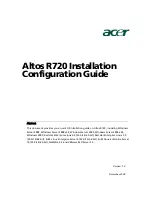
High-performance blade server optimized for virtualization
Please see the Legal Information section for important notices and information.
8.
1333MHz, the improvement is almost
500%
over the previous generation. This huge
improvement is mainly due to the dual integrated memory controllers and faster DDR3 1333MHz
memory. Throughput at 800MHz is
25 gigabytes per second
(GBps); at 1066MHz it’s
32GBps
;
and at 1333MHz it’s
35GBps
. This improvement translates into improved application
performance and scalability.
Memory interleaving refers to how physical memory is interleaved across the physical DIMMs. A
balanced system provides the best interleaving. A Xeon 5600 processor-based system is
balanced when all memory channels for a socket have the same amount of memory.
In the case of HS22V, which has a balanced DIMM layout, it is easy to balance the system for all
three memory frequencies. The recommended DIMM population is shown below, assuming
DIMMs with identical capacities.
Memory
Frequency
DIMMs per
Channel
Max. Memory
Capacity
5600 Series
5500 Series
1333MHz
2
(12 DIMMs)
192GB RDIMM
X5650, L5640,
E5645 and
above
N/A
1066MHz
3
(18 DIMMs)
288GB RDIMM
All
N/A
800MHz
3
(18 DIMMs)
288GB RDIMM
N/A
E5503/E5507
800MHz-
1333MHz
(Mirroring)
2
(12 DIMMs)
96GB RDIMM
All processors
All processors
A memory rank is simply a segment of memory that is addressed by a specific address bit.
DIMMs typically have 1, 2 or 4 memory ranks, as indicated by their size designation.
A typical memory DIMM description is
2GB 2Rx8 DIMM
:
The 4R designator is the rank count for this particular DIMM (R for rank = 2)
The x8 designator is the data width of the rank
It is important to ensure that DIMMs with appropriate number of ranks are populated in each
channel for optimal performance. Whenever possible,
it is recommended to use dual-rank
DIMMs
in the system. Dual-rank DIMMs offer better interleaving and hence better performance
than single-rank DIMMs. For instance, a system populated with six 2GB
dual
-rank DIMMs
outperforms a system populated with six 2GB
single
-rank DIMMs by
7%
for SPECjbb2005. Dual-
rank DIMMs are also better than quad-rank DIMMs because
quad-rank DIMMs will cause the
memory speed to be down-clocked
.
Another important guideline is to populate equivalent ranks per channel. For instance,
mixing
one single-rank DIMM and one dual-rank DIMM in a channel should be avoided
.
Note:
It is important to ensure that all three memory channels in each processor are populated.
The relative memory bandwidth decreases as the number of channels populated decreases. This
is because the bandwidth of all the memory channels is utilized to support the capability of the
processor. So, as the channels are decreased, the burden to support the requisite bandwidth is
increased on the remaining channels, causing them to become a bottleneck.
For peak performance:
Always populate both processors with equal amounts of memory to ensure a balanced
NUMA system.
Always populate all 3 memory channels on each processor with equal memory capacity.
Populate an even number of ranks per channel.
Use dual-rank DIMMs whenever appropriate.
For optimal
1333MHz
performance, populate with
12
dual-rank DIMMs (3 per processor, 2
per channel) for processsors that support 2 DIMMs per Channel (2DPC).
For optimal
1066MHz
performance, populate with
12
dual-rank DIMMs (6 per processor, 2
per channel).
For optimal
800MHz
performance with high DIMM counts, populate with
18
dual-rank or
quad-rank DIMMs (9 per processor) and clock memory down to 800MHz in BIOS.
With the above rules, it is not possible to have a performance-optimized system with 4GB,
8GB, 16GB, or 128GB. With 3 memory channels and interleaving rules, configure systems








































